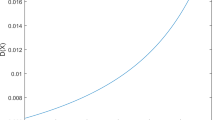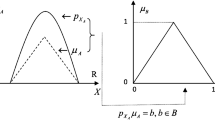Abstract
As an extension of Dempster-Shafer evidence theory, D numbers theory is developed with two more generalized properties that the elements in its frame of discernment do not require to be mutually exclusive strictly and the completeness constraint is released in its framework, which make it an effective tool for expressing and handling uncertain information. As a form of information representation and processing, there exists a certain amount of uncertainty in D numbers. How to reasonably measure the uncertainty of D numbers is still an open issue, and it is crucial to its further development and application. To address this issue, in this paper, a novel entropy function is defined to measure the uncertainty of D numbers, and based on which, the reliability indicator of D numbers is proposed motivated by TOPSIS method. Some numerical examples are given to illustrate the process of the proposed entropy function and reliability indicator, and in order to further demonstrate their effectiveness, a real-life application is conducted for bridge condition assessment problem using the developed D numbers approach.







Similar content being viewed by others
References
Bian T, Zheng H, Yin L, Deng Y (2018) Failure mode and effects analysis based on D numbers and topsis. Qual Reliab Eng Int 34(4):501–515
Cobb BR, Shenoy PP (2006) On the plausibility transformation method for translating belief function models to probability models. Int J Approx Reason 41(3):314–330
Dempster AP (1967) Upper and lower probabilities induced by a multivalued mapping. Ann Math Stat 38 (2):325–339
Deng X, Hu Y, Deng Y (2014) Bridge condition assessment using D numbers. Sci World J 2014:1–11
Deng X, Hu Y, Deng Y, Mahadevan S (2014) Environmental impact assessment based on D numbers. Expert Syst Appl 41(2):635–643
Deng X, Hu Y, Deng Y, Mahadevan S (2014) Supplier selection using ahp methodology extended by D numbers. Expert Syst Appl 41(1):156–167
Deng X, Jiang W (2017) Fuzzy risk evaluation in failure mode and effects analysis using a D numbers based multi-sensor information fusion method. Sensors 17(9):2086
Deng X, Jiang W (2018) An evidential axiomatic design approach for decision making using the evaluation of belief structure satisfaction to uncertain target values. Int J Intell Syst 33(1):15– 32
Deng X, Lu X, Chan FTS, Sadiq R, Mahadevan S, Deng Y (2015) D-CFPR: D numbers extended consistent fuzzy preference relations. Knowl-Based Syst 73:61–68
Deng Y (2012) D numbers: theory and applications. Int J Inf Comput Sci 9(9):2421–2428
Deng Y (2016) Deng entropy. Chaos, Solitons Fractals 91:549–553
Deng Y, Shi W, Zhu Z, Liu Q (2004) Combining belief functions based on distance of evidence. Decis Support Syst 38(3):489–493
Dubois D, Prade H (1985) A note on measures of specificity for fuzzy sets. Int J Gen Syst 10(4):279–283
Dubois D, Prade H (1987) Properties of measures of information in evidence and possibility theories. Fuzzy Sets Syst 24(2):161–182
Dunker KF, Rabbat BG (1995) Assessing infrastructure deficiencies: the case of highway bridges. J Infrastruct Syst 1(2):100–119
Fan G, Zhong D, Yan F, Yue P (2016) A hybrid fuzzy evaluation method for curtain grouting efficiency assessment based on an ahp method extended by D numbers. Expert Syst Appl 44:289–303
Fei L, Deng Y (2018) A new divergence measure for basic probability assignment and its applications in extremely uncertain environments. International Journal of Intelligent Systems, https://doi.org/10.1002/int.22066
Fei L, Deng Y, Hu Y (2018) DS-VIKOR: A New Multi-criteria Decision-Making Method for Supplier Selection. International Journal of Fuzzy Systems. https://doi.org/10.1007/s40815-018-0543-y https://doi.org/10.1007/s40815-018-0543-y
Han D, Liu W, Dezert J, Yang Y (2016) A novel approach to pre-extracting support vectors based on the theory of belief functions. Knowl-Based Syst 110:210–223
Hohle U (1982) Entropy with respect to plausibility measures. In: Proc of 12th IEEE Int Symp on Multiple Valued Logic, Paris, 1982s
Hwang CL, Yoon K (1981) Multiple Attribute Decision Making. Springer, Berlin
Jiang W, Hu W (2018) An improved soft likelihood function for Dempster-Shafer belief structures. Int J Intell Syst 33(6):1264–1282
Jiang W, Wei B, Liu X, Li X, Zheng H (2018) Intuitionistic fuzzy power aggregation operator based on entropy and its application in decision making. Int J Intell Syst 33(1):49–67
Jirousek R, Shenoy PP (2018) A new definition of entropy of belief functions in the Dempster-Shafer theory. Int J Approx Reason 92:49–65
Jousselme A, Liu C, Grenier D, Bosse E (2006) Measuring ambiguity in the evidence theory. IEEE Trans Syst Man Cybern Part A Syst Hum 36(5):890–903
Jousselme AL, Grenier D (2001) ÉLoi bossé: a new distance between two bodies of evidence. Information Fusion 2(2):91–101
Klein J, Colot O (2010) Automatic discounting rate computation using a dissent criterion. In: Workshop on the theory of belief functions, Brest, 1–6
Klir George J, Ramer A (1990) Uncertainty in the Dempster-Shafer theory: a critical re-examination. Int J Gen Syst 18(2):155–166
Klir GJ, Parviz B (1992) A note on the measure of discord. In: Eighth International conference on uncertainty in artificial intelligence, pp 138–141
Klir GJ, Wierman MJ (1999) Uncertainty-Based Information. Physica-Verlag HD
Lamata MT, Moral S (1988) Measures of entropy in the theory of evidence. Int J Gen Syst 14(4):297–305
Li M, Hu Y, Zhang Q, Deng Y (2016) A novel distance function of D numbers and its application in product engineering. Eng Appl Artif Intell 47:61–67
Li X, Chen X (2018) D-intuitionistic hesitant fuzzy sets and their application in multiple attribute decision making. Cogn Comput 10(3):496–505
Liang MT, Wu JH, Liang CH (2001) Multiple layer fuzzy evaluation for existing reinforced concrete bridges. J Infrastruct Syst 7(4):144–159
Lin S, Li C, Xu F, Liu D, Liu J (2018) Risk identification and analysis for new energy power system in China based on D numbers and decision-making trial and evaluation laboratory (dematel). J Clean Prod 180:81–96
Liu HC, You JX, Fan XJ, Lin QL (2014) Failure mode and effects analysis using D numbers and grey relational projection method. Expert Syst Appl 41(10):4670–4679
Liu ZG, Pan Q, Dezert J (2013) Evidential classifier for imprecise data based on belief functions. Knowl-Based Syst 52(6):246–257
Martin A, Jousselme A, Osswald C (2008) Conflict measure for the discounting operation on belief functions. In: 2008 11th International conference on information fusion, pp 1–8
Mo H, Deng Y (2016) A new aggregating operator for linguistic information based on D numbers. Int J Uncertainty Fuzziness Knowledge Based Syst 24(6):831–846
Nguyen HT (1985) On entropy of random sets and possibility distributions. In: Bezdek JC (ed) The analysis of fuzzy information, CRC Press, pp 145–156
Pal NR, Bezdek JC, Hemasinha R (1992) Uncertainty measures for evidential reasoning i: a review. Int J Approx Reason 7(3):165–183
Pal NR, Bezdek JC, Hemasinha R (1993) Uncertainty measures for evidential reasoning ii: a new measure of total uncertainty. Int J Approx Reason 8(1):1–16
Ramer A (1987) Uniqueness of information measure in the theory of evidence. Fuzzy Sets Syst 24(2):183–196
Samet A, Lefèvre E, Yahia SB (2014) Integration of extra-information for belief function theory conflict management problem through generic association rules. Int J Uncertainty Fuzziness Knowledge Based Syst 22 (4):531–551
Shafer G (1976) A Mathematical Theory of Evidence, vol 1. Princeton University Press, Princeton
Smets P (1983) Information content of an evidence. Int J Man Mach Stud 19(1):33–43
Sun L, Liu Y, Zhang B, Shang Y, Yuan H, Ma Z (2016) An integrated decision-making model for transformer condition assessment using game theory and modified evidence combination extended by D numbers. Energies 9(9):1–22
Tang Y, Zhou D, Xu S, He Z (2017) A weighted belief entropy-based uncertainty measure for multi-sensor data fusion. Sensors 17(4):1–15
Wang N, Liu F, Wei D (2016) A modified combination rule for D numbers theory. Math Probl Eng 2016(2):1–10
Wang N, Liu X, Wei D (2018) A modified D numbers’ integration for multiple attributes decision making. Int J Fuzzy Syst 20(1):104–115
Wang YM, Elhag TM (2008) Evidential reasoning approach for bridge condition assessment. Expert Systems with Applications 34(1):689–699
Wang YM, Elhag TMS (2007) A fuzzy group decision making approach for bridge risk assessment. Comput Ind Eng 53(1):137–148
Xia J, Feng Y, Liu L, Liu D (2018) Information fusion model of innovation alliances based on bayesian networks. Tsinghua Sci Technol 23(3):347–356
Xia J, Feng Y, Liu L, Liu D, Fei L (2018) An evidential reliability indicator-based fusion rule for dempster-shafer theory and its applications in classification. IEEE Access 6:24,912– 24,924
Xiao F (2016) An intelligent complex event processing with D numbers under fuzzy environment. Math Probl Eng 2016(1):1– 10
Xiao F (2017) A novel evidence theory and fuzzy preference approach-based multi-sensor data fusion technique for fault diagnosis. Sensors 17(11):2504
Xiao F (2018) An improved method for combining conflicting evidences based on the similarity measure and belief function entropy. Int J Fuzzy Syst 20(4):1256–1266
Yager RR (1983) Entropy and specificity in a mathematical theory of evidence. Int J Gen Syst 9(4):249–260
Zhou X, Deng X, Deng Y, Mahadevan S (2017) Dependence assessment in human reliability analysis based on D numbers and AHP. Nucl Eng Des 313:243–252
Acknowledgments
The authors greatly appreciate the reviews’ suggestions and the editor’s encouragement. This research was funded by the grants from the National Natural Science Foundation of China (#71472053, #71429001, #91646105).
Author information
Authors and Affiliations
Corresponding authors
Additional information
Publisher’s note
Springer Nature remains neutral with regard to jurisdictional claims in published maps and institutional affiliations.
Rights and permissions
About this article
Cite this article
Xia, J., Feng, Y., Liu, L. et al. On entropy function and reliability indicator for D numbers. Appl Intell 49, 3248–3266 (2019). https://doi.org/10.1007/s10489-019-01442-3
Published:
Issue Date:
DOI: https://doi.org/10.1007/s10489-019-01442-3




